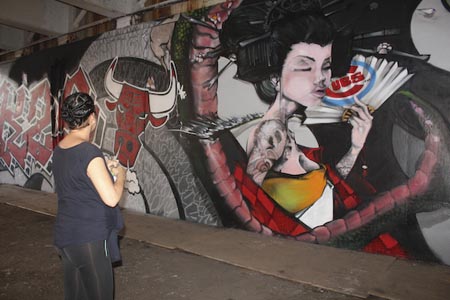In tough economic times, it is hard to justify large expenditures on art -- or is it? This summer, the city of Chicago has several large scale temporary art sculptures installed in the heart of the city, paid for by non-governmental organizations. Navy Pier, in its Gateway Park which welcomes visitors to the area before the pier jettisons straight into Lake Michigan, launched its BIGart exhibition this May. It erected a signature Lichtenstein sculpture, Brushstroke Group, and an Anthony Caro sculpture, entitled, Blazon. It also commissioned an incredible Nancy Rubins sculpture, Monochrome for Chicago, 2012, consisting of 41 suspended canoes weighing over 5,000 pounds and supported by structures weighing 160,000 pounds, and Gajin Fujita's CHI-TOWN mural at the viaduct under Lake Shore Drive at Grand Avenue. BIGart will be up through October and cost Navy Pier over $100,000.
Chicago Loop Alliance has also worked up some large scale public art. It commissioned Jessica Stockholder's Color Jam, the largest piece of public artwork in Chicago's history. The three-dimensional vinyl artwork, which envelopes the downtown crossing of State and Adams with flashes of color and geometric shapes that spill from building facades onto the sidewalk and streets is composed of over 76,000 square feet of colored vinyl -- enough material to make 50,000 vinyl records or wrap 130 city buses! Color Jam will intersect with pedestrians and traffic now through September 30, 2012. An aerial video feed of Color Jam is streaming live atcolorjamchicago.com.
Chicago Loop Alliance isn't saying how much it spent on this impermanent piece; however, it is a good guess that it ain't cheap. So when no one has a penny to spend and budgets are as slim as a Hollywood waistline, at first glance it may be surprising that these organizations are putting forth large sums on public art. Upon further pondering, maybe it isn't as crazy as all that.

Nancy Rubins'Monochrome for Chicago, 2012 in mid-construction. Photo credit: Meg Handler/Navy Pier
1. Chicago has over 700 pieces of permanent artwork in over 100 areas in the city. Economy be damned, Chicago is determined to remain on the forefront of modern art and architecture with continued, large scale works of international import. In Jessica Stockholder's words: "Doing things and bringing life to communities helps the economy of those communities. Nothing was ever gained by sitting around, particularly in tough economic times." Chicago is regarded an important art city and it is going to stay that way, even in an economic downturn.
2. More obvious and well-known than the above factoid is that Chicago's downtown is a major international tourist attraction and destination due largely to its incredible beauty. Large scale artwork plays an important role in this equation, bringing tourist dollars to the city, as Anish Kapoor's Cloud Gate, aka The Bean, has shown. And tourist dollars in summer, no surprise, are king! Even if one is in town for a short weekend and does the most cursory of things, on the way to these things the experience is incredibly, visually interesting: mammoth, interactive art, life-changing architecture, and the lakefront, all solidifying a beautiful and pleasant tourist experience. Cha-ching.
3. Much harder to quantify, but certainly of enormous value, is the richness the artwork brings to the everyday life of those who live here. If the sculpture appeals to you, great! Instant pleasure! Some art like Gajin's CHI_TOWN mural at the Lake Shore Drive and Grand underpass which has several Chicago sports references in and among the graffiti street art might make an easy connection with the general public. Some pieces, like my personal favorite, Agora, the eerie headless and armless heard of towering bodies in mid-stride by Magdalena Abakanowicz may make a slower connection. Yet, even if the art doesn't appeal to you, there is an emotional reaction, a visceral registry that you are still feeling, still engaging, still beating. Sadly, with the integration of technology into our every waking second, the opportunities to check in with ourselves and each other don't occur often enough. Large scale public works offer this. They give us a chance to dialogue with ourselves and each other about what we feel and what we think. Amen.

CHI_TOWN, Gajin Fujita mural. Photo credit: Meg Handler/Navy Pier
But why take my word for it? Maria Popova, in her wonderful blog Brainpickings.org writes, "This is the power of art: The power to transcend our own self-interest, our solipsistic zoom-lens on life, and relate to the world and each other with more integrity, more curiosity, more wholeheartedness."
In the same blog, Maria also quotes Leo Tolstoy who shared the same philosophy. "Art is not, as the metaphysicians say, the manifestation of some mysterious idea of beauty or God; it is not, as the aesthetical physiologists say, a game in which man lets off his excess of stored-up energy; it is not the expression of man's emotions by external signs; it is not the production of pleasing objects; and, above all, it is not pleasure; but it is a means of union among men, joining them together in the same feelings, and indispensable for the life and progress toward well-being of individuals and of humanity."
In an interview for Fear No ART, international sculptor Tony Tasset gave me his take on public art. "I don't know if it makes economic sense or not, but art has always been there -- in good economic times and bad economic times -- artists keep creating and its not going away." I agree with him. Good economy or bad, slashed public funds or not, it doesn't really matter. Art holds up a type of mirror that, through probing, reminds us of who we are and what we believe. That's a bargain at any price.

Jessica Stockholder's Color Jam. Photo credit: Kevin Shelton, courtesy of the Chicago Loop Alliance.
Nancy Rubins, whose Monchrome for Chicago, 2012 canoe sculpture opens like a bouquet of metal juxtaposed the city skyline, perhaps sums it up best. "Art should be made whenever you can." That sure makes sense to me.
